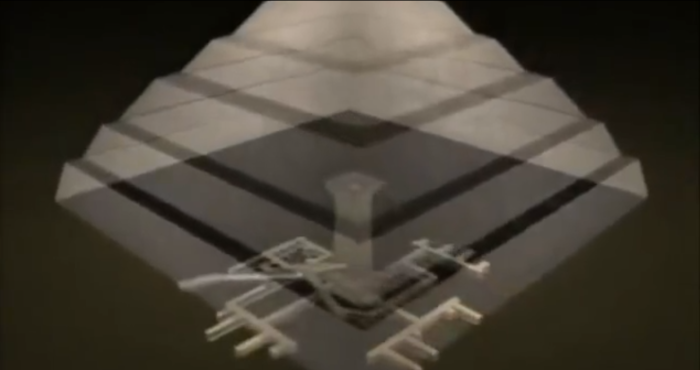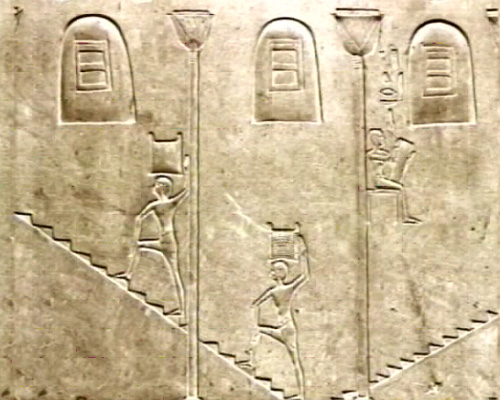Posts Tagged ‘shaft’
The Step Pyramid was built on top of a prototypical grain silo that was converted into a tomb
The Step Pyramid complex of Djoser contains a dozen shafts that appear to be grain storage bins accessible via tunnels connected to the bottom of the pits and linking to a central open stairwell. Interestingly, there is a shaft with similar dimensions right underneath the center of the Step Pyramid. The shaft obviously predates the pyramid. Access to the shaft was via a closed in stairwell linking to tunnels around it’s base. It would appear that this was a prototype grain silo. Ventilation would have been a problem and it was likely that it was abandoned as a silo once the better ventilated silos were operational. The abandoned silo was subsequently used as a burial chamber for the Pharaoh when he died in the 5th year of the famine. It was encased with ornate limestone and sealed with a granite slab after the pharaoh’s sarcophagus had been lowered into it. A mastaba was built on top of it using solid limestone blocks. Successive mastabas were added to bury the the Pharaoh’s 3 wives and 11 daughters. The result was the Stepped Pyramid.
The Left entrance would have required a ladder or a rope to get in and out while the Right entrance had stairs.


The main entrance leads straight to the Central Shaft in which Djoser’s Sarcophagus was placed. The Right tunnel leads to another tunnel that gradually descends and connects to the galleries connecting to the bottom of the shaft. The Left entrance tunnel leads to a vertical shaft that connects to the another set of galleries that are a bit like a maze. The only way out would be through the central shaft to the galleries on the Right that connect to the stairs or to climb back up the vertical shaft in the Left entrance. If the central shaft was full of grain it would not be possible to cross through to the Right side from the Left. People who fell down the vertical shaft in the Left entrance tunnel would, therefore, be trapped if they survived the fall (unless they had a ladder or a rope to climb back up). This is a scary thought!
Djoser’s sarcophagus was placed on a platform which was above the level of the galleries and tunnels that connected to the bottom of the shaft. It was therefore possible to cross from L to R through the central shaft underneath Djoser’s sarcophagus when the shaft was being used as a tomb.
The Step Pyramid was built on top of a shaft in which Djoser’s Sarcophagus was placed


Heiroglyphs of Egyptians retrieving grain from underground silos using an open stairwell.
Were the tunnels under the step Pyramid used to trick robbers or were they used to retrieve grain?






On careful inspection of the above diagrams, it would appear that the entrance tunnel connects with 4 other tunnels that lead directly to the central chamber where the sarcophagus of Djoser was placed. These tunnels actually go right under the platform on which the sarcophagus was placed. While these tunnels do have branches with blind endings, it is unlikely that somebody would get lost in them and not find the central chamber.
These tunnels would have lead grave robbers straight to the tomb once they had been breached. This is exactly what happened. The mummy of Netjerikhet (Djoser/Zozer) was in fact stolen by grave robbers and all that remains is one of Netjerikhet’s feet.
It is much more likely that the central shaft was originally used as a grain silo and the grain flowed into these underground tunnels to some degree thereby increasing the capacity of the silo and making it safe to retrieve the grain without being buried in it.
There would have been a problem of ventilation and hence the necessity to construct another series of interconnected shafts to store grain very close to the Step Pyramid and accessible through tunnels whose entrance was at the bottom of pits within the walls of the Step Pyramid Complex.
The Step Pyramid complex was originally designed as a grain storage and distribution center. It’s entrance is through a building with tall columns shaped like corn. This building would have been where the corn was traded; a short walk to the pit where the grain was retrieved from the underground tunnels connecting to the grain silos.
When the time came to bury Djoser (Netjerikhet), Joseph / Imhotep constructed a platform at the bottom of the first silo and lined the shaft with ornate limestone. Djosers Sarcophagus was lowered into the shaft from above. The top of the shaft was then sealed with an enormous slab of granite and a mastaba was constructed on top. Successive mastabas were added to bury the other members of Djoser’s family when théy died. Eventually, the stack of mastabas took the form of a Stepped Pyramid. The Stepped Pyramid was eventually faced with smooth limestone which over the centuries has fallen down leaving the Step Pyramid in it’s current state.
The Step Pyramid complex was therefore originally intended to be a grain storage and distribution center in Saqqara. When Jospeh / Imhotep’s pharaoh died, the original shaft was used as a burial chamber for Netjerikhet (Djoser/Zozer) and a mastaba was built on top. Successive mastabas were added to form the Step Pyramid and a Morturary complex was built next to it within the walls of the Step Pyramid complex which continued to be used as a grain storage and distribution center for many centuries.
The Egyptions attributed Jospeh / Imhotep’s achievements to Ra but in fact it was Yahweh / Jehovah who was behind it all!
Pharaoh Djoser’s (Netjerikhet’s) sarcophagus was placed a the bottom of a central shaft by Imhotep who then built a series of limestone mastabas which were stacked on top of one another to form the Step Pyramid.

- Could the central shaft have been the first grain silo that Imhotep built for the Pharaoh?
- It differed from other pits used to store grain in that it was lined or cased with large decorated limestone blocks.
- The limestone casing and roof of the burial chamber eventually collapsed and crushed Djoser’s sarcophagus.
- (It was around 500BC when it collapsed but it was not until 2007 that the rubble could be cleared by a team lead by Dr Zahi Hawass.)
Did Imhotep bury the Pharaoh in one of the shafts that he originally made to store grain?
- There are 3.5 miles of tunnels under the Step Pyramid
- Dr. Zahi Hawass
- The main tunnel leading to the burial chamber
- The central shaft was built first, Was it originally made to sore grain?
- The central shaft was lined with large limestone blocks which eventually collapsed falling onto and smashing the sarcophagus (about 500yrs BC).
- The Step Pyramid was built on top of a shaft similar to the other shafts in the complex used to store grain
- Did Imhotep bury the Pharaoh in a grain silo and then construct the Step Pyramid on top of it?
- Statue of ?Djoser with Imhotep’s name and titles inscribed on it.
- Was Djoser buried in the first grain silo built by Imhotep?
- Imhotep lowered the Sarcophagus of the Pharaoh into the central shaft and then sealed the top of the shaft and built a mastaba on top of it. Then he added more mastabas for the rest of Djoser’s family.
- The Step Pyramid was constructed on top of the central shaft after the Pharaoh was buried in it.
- The Sarcophagus of Pharaoh Djoser was at the bottom of the central shaft.
- Pharaoh Djoser (Netjerikhet)
- The entrance to the burial chamber
- Imhotep designed false passageways and blind ending tunnels to throw off grave robbers.
- Could the central shaft have been the first grain silo that Imhotep built for the Pharaoh?
- 11 of Djosers daughters were also buried in the Step Pyramid which is just a series of mastabas stacked on top of one another.
- Was the Burial Chamber originally a grain silo?
- Imhotep in heiroglyphics
- The remains of a mudbrick Mastaba situated about one kilometer from the Step Pyramid at Saqqara
- A computer generated reconstruction of a mudbrick mastaba that was used as a burial chamber for the first dynasty pharaohs.
- The central shaft was the burial chamber for the Pharaoh
- The central shaft had similar dimensions to other shafts used to store grain
- The Sarcophagus of Pharaoh Djoser was at the bottom of the central shaft.
- This central shaft became the burial chamber for the Pharaoh Djoser (Netjerikhet)
- Imhotep
- Imhotep
- The Step Pyramid was built in stages. At first, just one mustaba sat on top of the central shaft in which the Pharaoh was buried. More mastabas were added next to and on top of the previous ones.
The Step Pyramid was built on top of a Shaft in which the Pharaoh was buried. Was this shaft originally used to store grain or was it made for this purpose?
The shaft was cased with large limestone blocks and the top was sealed. A limestone mastaba was constructed over it. Successive layers were then added to the mastaba to bury the rest of Djoser’s family. The final result was the Step pyramid.
In about 500BC the limestone casing in the shaft collapsed, crushing Djoser’s sarcophagus. It was only in recent times that the rubble in the tomb has been cleared and the tomb inspected.
The shaft would have had to have been constructed before the pyramid was constructed.
This means that Djoser must have died and been placed in the shaft before the construction of the Step Pyramid. The famine occurred during Djoser’s life time as did the seven years of plenty. Maybe the shaft was originally used to store grain and later was lined with limestone and used as a burial chamber. A limestone mastaba was contructed on top of the burial chamber and then successive mustabas were added to bury Djoser’s 11 daughters and three wives. The original mastaba was extended horizontally and then vertically (stacking one upon another) resulting in a Step Pyramid which was then faced with nicely cut limestone (which has fallen down over the centuries).








































































